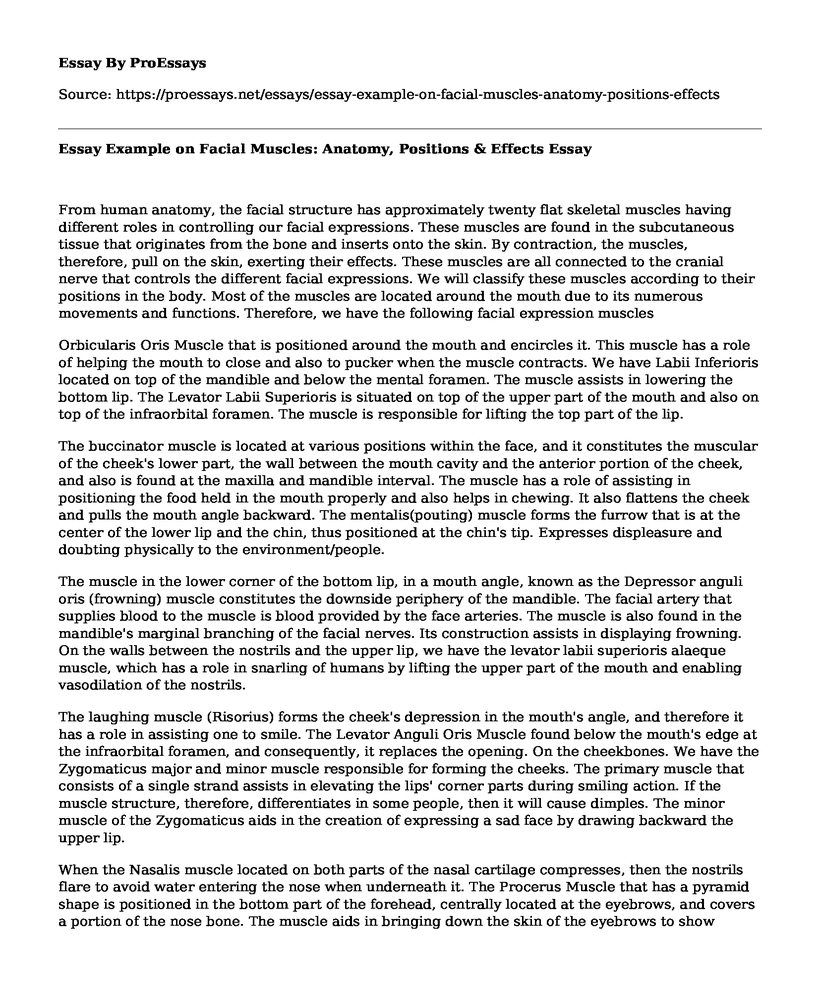From human anatomy, the facial structure has approximately twenty flat skeletal muscles having different roles in controlling our facial expressions. These muscles are found in the subcutaneous tissue that originates from the bone and inserts onto the skin. By contraction, the muscles, therefore, pull on the skin, exerting their effects. These muscles are all connected to the cranial nerve that controls the different facial expressions. We will classify these muscles according to their positions in the body. Most of the muscles are located around the mouth due to its numerous movements and functions. Therefore, we have the following facial expression muscles
Orbicularis Oris Muscle that is positioned around the mouth and encircles it. This muscle has a role of helping the mouth to close and also to pucker when the muscle contracts. We have Labii Inferioris located on top of the mandible and below the mental foramen. The muscle assists in lowering the bottom lip. The Levator Labii Superioris is situated on top of the upper part of the mouth and also on top of the infraorbital foramen. The muscle is responsible for lifting the top part of the lip.
The buccinator muscle is located at various positions within the face, and it constitutes the muscular of the cheek's lower part, the wall between the mouth cavity and the anterior portion of the cheek, and also is found at the maxilla and mandible interval. The muscle has a role of assisting in positioning the food held in the mouth properly and also helps in chewing. It also flattens the cheek and pulls the mouth angle backward. The mentalis(pouting) muscle forms the furrow that is at the center of the lower lip and the chin, thus positioned at the chin's tip. Expresses displeasure and doubting physically to the environment/people.
The muscle in the lower corner of the bottom lip, in a mouth angle, known as the Depressor anguli oris (frowning) muscle constitutes the downside periphery of the mandible. The facial artery that supplies blood to the muscle is blood provided by the face arteries. The muscle is also found in the mandible's marginal branching of the facial nerves. Its construction assists in displaying frowning. On the walls between the nostrils and the upper lip, we have the levator labii superioris alaeque muscle, which has a role in snarling of humans by lifting the upper part of the mouth and enabling vasodilation of the nostrils.
The laughing muscle (Risorius) forms the cheek's depression in the mouth's angle, and therefore it has a role in assisting one to smile. The Levator Anguli Oris Muscle found below the mouth's edge at the infraorbital foramen, and consequently, it replaces the opening. On the cheekbones. We have the Zygomaticus major and minor muscle responsible for forming the cheeks. The primary muscle that consists of a single strand assists in elevating the lips' corner parts during smiling action. If the muscle structure, therefore, differentiates in some people, then it will cause dimples. The minor muscle of the Zygomaticus aids in the creation of expressing a sad face by drawing backward the upper lip.
When the Nasalis muscle located on both parts of the nasal cartilage compresses, then the nostrils flare to avoid water entering the nose when underneath it. The Procerus Muscle that has a pyramid shape is positioned in the bottom part of the forehead, centrally located at the eyebrows, and covers a portion of the nose bone. The muscle aids in bringing down the skin of the eyebrows to show anger. Orbicularis Oculi muscle surrounds the eyelids and therefore assists in the closing of the eyes. Corrugator Supercilii eye muscle that has a connection with the Orbicularis Oculi muscle aids in moving the eyebrow.
Conclusion
Though we have not mentioned all the muscles involved in facial expressions, all of them play an upper hand in achieving the varied forms of facial expressions in human beings.
Cite this page
Essay Example on Facial Muscles: Anatomy, Positions & Effects. (2023, Jul 12). Retrieved from https://proessays.net/essays/essay-example-on-facial-muscles-anatomy-positions-effects
If you are the original author of this essay and no longer wish to have it published on the ProEssays website, please click below to request its removal:
- Essay Example on Human Cloning
- Human Long Bone, Compact and Spongy Bone Paper Example
- Animal Bushmeat and Ethics Essay
- Essay Example on Gastrointestinal Tract: Functions and Disorders
- Anatomy and Physiology in Stress Conditions
- Essay Example on Winter Survival: Nature's Mysteries, Animal Adaptations
- Paper Sample on Discrimination Training: Impact on Stimulus Simplification in Humans & Animals







